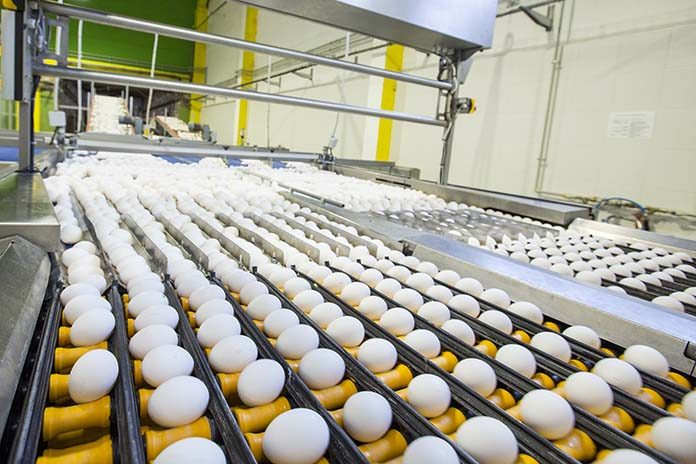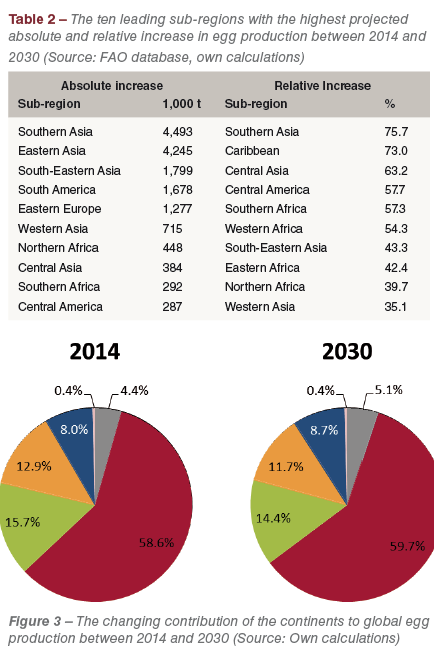
This paper presents a projection of the future dynamics in egg production. Because of the high volatility in the per capita consumption and in production, projections on the future development of egg production are no longer published in the OECD-FAO Agricultural Outlooks or by the USDA.
In 2014, the Author of this report presented a projection of global egg production until 2030 to the IEC. The projection of 2014 will be updated in this paper.
The projected development of egg production between 2014 and 2030 for continents and sub-regions
 In Figure 1, the projected development of egg production between 2014 and 2030 is documented for continents and sub-regions. Because of the incomplete data for many countries, a projection at country level cannot be presented at the moment.
In Figure 1, the projected development of egg production between 2014 and 2030 is documented for continents and sub-regions. Because of the incomplete data for many countries, a projection at country level cannot be presented at the moment.
Table 1 shows that a growth of the global production volume by 18.3 mill. t or 27.3 % is expected for the time period between 2014 and 2030. The highest absolute growth rate is projected with 11.6 mill. t for Asia, followed by Central and South America with 2.1 mill. t, Europe with 1.7 mill. t and Africa with 1.4 mill. t. It may be surprising that for North America only an increase by 1.3 mill. t is expected (Figure 1). The reason is the already very high per capita consumption in Mexico, the USA and Canada.  The projected growth is mainly based on the population dynamics.
The projected growth is mainly based on the population dynamics.
The highest relative growth rate is predicted for Africa with 47.2 %, followed by Central and South America with 38.7 % and Asia with 28.4 %. The relative growth rates in Oceania (11.5 %), North America (14.9 %) and Europe (15.7 %) are considerably lower. This reflects the already high egg consumption in the old industrialised countries, while in the other continents a fast increase of consumption is expected in several of the least and less developed countries.
Because of the high absolute growth in the production volume, Asia will contribute 63.5 % to the projected increase of egg production between 2014 and 2030, followed by Central and South America with 11.7 % and Europe with 9.4 %. The contribution of North America with 7.3 % is lower than that of Africa with 7.9 %. Oceania, because of its low population and peripheral location regarding the possibility of egg exports, will only share 0.2 % in the global increase.
Sub-regions with the highest absolute and relative increase of egg production
 In Table 2 and Figure 2, the ten sub-regions with the highest absolute and relative increase of egg production between 2014 and 2030 are listed. Of the ten sub-regions with the highest absolute growth, five are located in Asia, two in Africa, two in Central and South America and one in Europe. The three sub-regions with the highest increase are located in Asia which documents the extraordinary role which this continent will also in future play in the development of egg production. Of the ten sub-regions with the highest relative growth, four are located in Asia, four in Africa and two in Central and South America.
In Table 2 and Figure 2, the ten sub-regions with the highest absolute and relative increase of egg production between 2014 and 2030 are listed. Of the ten sub-regions with the highest absolute growth, five are located in Asia, two in Africa, two in Central and South America and one in Europe. The three sub-regions with the highest increase are located in Asia which documents the extraordinary role which this continent will also in future play in the development of egg production. Of the ten sub-regions with the highest relative growth, four are located in Asia, four in Africa and two in Central and South America.
 A comparison of the composition and ranking reveals the expected dynamical development in Africa besides that in Asia. Despite the high relative growth rates, the absolute increase in the two sub-regions in Central and South America are comparatively low. The fact that neither North America nor any European sub-region rank among the ten leading regions with the highest relative increase not only documents the location of the new growth centres outside Europe and North America but also the ongoing globalisation of egg production.
A comparison of the composition and ranking reveals the expected dynamical development in Africa besides that in Asia. Despite the high relative growth rates, the absolute increase in the two sub-regions in Central and South America are comparatively low. The fact that neither North America nor any European sub-region rank among the ten leading regions with the highest relative increase not only documents the location of the new growth centres outside Europe and North America but also the ongoing globalisation of egg production.
The contribution of the continents to global egg production
The differences in the projected dynamics will have impacts on the contribution of the continents to global egg production. Figure 3 shows that Asia, Africa and Central and South America will have higher shares in 2030 than in 2014 while Europe and North America will lose, respectively, 1.3 % and 1.2 % of their former contribution. This data again documents that also in the next 15 years the spatial shift of the growth poles in egg production from Europe and North America to Asia, Africa and Central and South America will continue.
Egg trade and consumption
Less than 3 % of the global egg production is traded. As shell eggs cannot be deep-frozen and the shelf-life of eggs is comparatively short, shell eggs are mainly traded over short distances. This is also the case in trade with liquid egg products while egg powder can be traded over long distances because of its long storage life. Therefore, the spatial patterns of shell eggs, liquid egg products and egg powder differ considerably. Most of the shell eggs for consumption are traded within the EU, between the three NAFTA member countries and between Malaysia and Singapore. The trade patterns are quite stable and it is not expected that in particular trade with shell eggs for consumption and with liquid egg products will change thoroughly over the next decade.
This paper is abridged version of a special report which the Author prepared for the International Egg Commission (IEC)

















